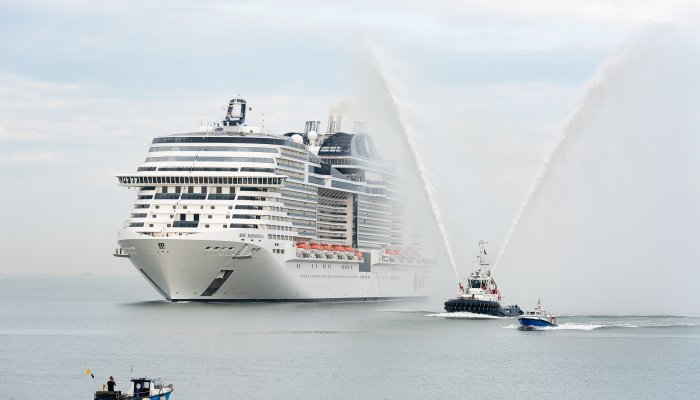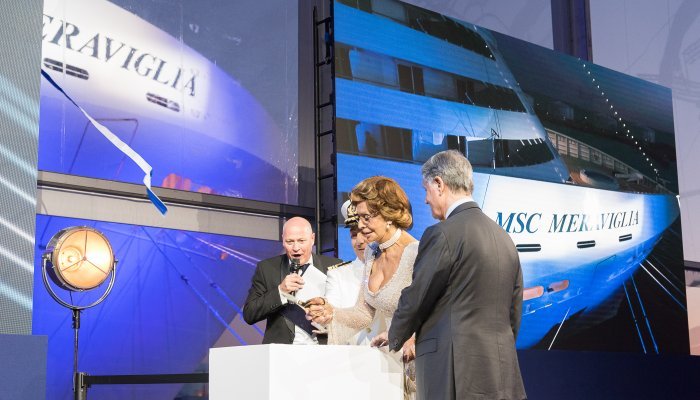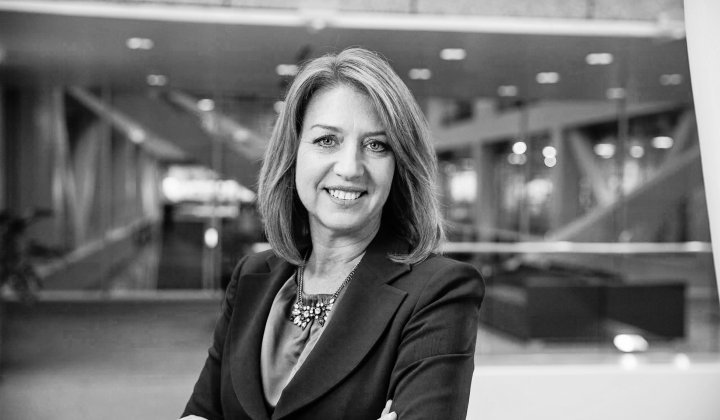According to Cruise Lines International Association, the global cruise industry capacity grew from 17.8m passengers in 2009 to an estimated 25.8m in 2017.
“Cruising is an alternative to a vacation,” says Pierfrancesco Vago, Executive Chairman of MSC Cruises, the Swiss-based arm of the international shipping group. “We still have first-timers that are a problem because they don’t understand cruising. They still think of The Love Boat – black-tie, boring, expensive, and only for old people – [even though] cruising has evolved.”
While the growth in the cruise industry outpaced global land-based tourism by 20% from 2004 to 2014, penetration rates remain as low as 1.7% in Western Europe, 2.6% in the United Kingdom, and 3.4% in North America. This, coupled with the fact that 48% of non-cruisers surveyed by CLIA expressed interest in a holiday at sea, represents a massive potential for growth.
“We’re the last kid on the block,” Vago laughs. “We entered the cruise industry in the late 1990s with three ships. One day we realised the cruise industry had evolved, exactly as we know it today. So we started our industrial growth plan.”
From 2003 to 2013, MSC Cruises invested €6 billion and built a dozen ships in three flexible groups. First was the Lirica class: the MSC Lirica (2003), MSC Opera (2004), MSC Armonia (2004), and MSC Sinfonia (2005). Next was the Musica class: the MSC Musica (2006), MSC Orchestra (2007), MSC Poesia (2008), and MSC Magnifica (2010). Last was the Fantasia class: MSC Fantasia (2008), MSC Splendida (2009), MSC Divina (2012), and MSC Preziosa (2013).
“We’ve had 800% growth in the first ten years,” Vago says, adding that passenger numbers increased more than fourteen-fold from 127 000 guests in 2003 to 1.8 million in 2016. “We needed to reach economies of scale. But then we didn’t have any ships because we grew so fast and wanted to have three years of no growth. We needed to stabilise the company. We wanted systems, processes and the economies of scale to kick in. But now we’re ready for the big second wave of growth.”
Building a ‘rich’ ship
In 2014, MSC Cruises launched an investment plan to support this new phase of growth. One aspect was a two-year Renaissance Programme, which invested €200 million for an extensive overhaul of the entire Lirica class. The company also decided to invest €9 billion in building up to eleven new next-generation mega-ships between 2017 and 2026.
The first of these is the MSC Meraviglia (the G is silent), a ship the company refers to as the “Eighth Wonder of the World”. It’s not just because the name means ‘wonder’ or ‘marvel’ in Italian, but also because it’s the biggest one ever built by a European ship owner. At 315m long, 43m wide and 19 decks high, it’s also the largest ship to come into service this year.
“Words are sometimes difficult to explain how much there is in a ship today – the capacity to innovate and design is complex – but the MSC Meraviglia emphasises what the present and future of cruising is all about,” Vago says. “This ship is incredible. It allows us to give a variety of itineraries throughout Europe and the world.”
The ship took three years of planning, 26 months of construction and 1 700 workers per month (over 3 000 per month during peak periods) for a total of nine million man-hours. It was built by STX France, further reinforcing a long-standing partnership that has already produced all vessels in the fleet so far.
“Our aim was not to build a big ship,” says Gianni Onorato, CEO of MSC Cruises. “Our aim was to build a rich ship that offers features and amenities to accommodate people who are already used to cruising and people who have never thought of going on a cruise in their lives. This is what inspires our concept when we think about new platforms.”
The MSC Meraviglia accommodates over 5 700 guests and more than 1 500 employees. And while Onorato highlights the need for comfortable suites (and the fact that 75% of the ship’s cabins have balconies) he explains that people are more concerned with where they’ll be going instead of where they’ll be staying.
For its inaugural season, the MSC Meraviglia is sailing through the Mediterranean on seven-night cruises with six ports of call: Genoa, Naples, Messina, Valletta, Barcelona and Marseille. The company added nineteen new shore excursions (five of which are exclusive to the ship), offering more than 80 altogether.
“The number one driver of choosing a cruise will always be the destinations,” Onorato says. “And when we say that this is a ship for all seasons, this is also a ship for all ports. This is proved by the itineraries that have already been designed and worked out.”
Desgining the future
While the MSC Meraviglia is designed for all seasons – next year’s itinerary will see it embark on long cruises through Northern Europe – the company is launching another class designed for warmer climes. The Seaside category will include the MSC Seaside (launching in Miami in December 2017), the MSC Seaview (launching in Rome in June 2018), and an option for a third ship in 2021. In 2019 the company will also launch the MSC Bellissima, a sister ship to the MSC Meraviglia, as well as the extended Meraviglia-Plus Class.
“We’re so happy with the results of this platform that we decided to add an extra 50m in the promenade because we want to give an even bigger ‘wow’ factor,” Vago says. “So we’ll have two Meraviglia-Plus Class deliveries: one at the end of 2019 and the other in the spring of 2020… We’re going to have a real museum. We’re talking with the Italian ministry and museums in Florence, the Louvre in France and the Museo Nacional Del Prado in Spain to have masterpieces on board.”
MSC Cruises has also confirmed the order of two ships for its World Class. With a futuristic Y-shape for panoramic sea views and a maximum capacity of close to 7 000 guests, these ships (to launch in 2022 and 2024, with an option for two more in 2025 and 2026) will be the largest by passenger capacity in the world.
“We’re extending the growth and industrial plan for the next ten years but with the measures that we can operate in all the ports in the world,” Vago says. “Big is great but we want to be able to go everywhere. MSC Cruises is a global brand so these ships will be operating globally.”
Planning so far ahead is tricky, especially when major capital expenditure is involved. But Vago believes that “designing the future” is an exciting prospect.
“We’re designing something that will be delivered in 2026 but ten years later, in 2036, will have to be ‘actual’,” he says. “That means we’re designing what the experience in 2036 will be: what people will want and expect in terms of entertainment, food and so on. This is the challenge and the beauty of this business.”
Democratising luxury
Still, Vago is confident that these developments will allow MSC Cruises to triple its passenger numbers (from 1.8 million to 4.8 million) in the next ten years. While it’s currently the world’s fourth largest cruising company by capacity, it ranks as the number one brand in Europe, South America and South Africa. It’s also the largest privately owned cruising company in the world.
“Today we offer 194 itineraries,” Vago says of its trips to 86 countries and 199 ports of call around the world. “We welcome over 192 nationalities on-board so the capacity to deliver an experience that pleases is incredible. In fact, we have such a presence and such a distribution because of our ticketing and selling in 67 countries.”
Vago believes that the appeal of cruising compared to land-based holidays is about value for money, waking up in a different place every day, and the ship itself becoming a destination. Indeed, with nine out of ten customers becoming repeat guests, he’s confident that word-of-mouth will be a big promoter.
“The capacity to reach each segment of the population – all tastes, all ages and all pockets – is the strength of the cruising industry and experience versus other types of holidays,” he says. “We’re always talking about democratisation of luxury with the cruising experience. That’s why cruising is so successful.”
Keeping MSC Cruises afloat in potentially stormy seas are its people. The company has close to 18 000 on-board and on-shore employees and, by sourcing more through its global training centres, aims to create 25 000 new jobs by 2026. Controlling all products from A to Z in-house also allows it to “fine-tune and deliver” on its offering.
“We’re a family company with 300 years of seafaring tradition,” Vago says. “We’re in a capital-demanding industry and I think it’s a huge advantage that we can keep that family spirit, that attachment to the company and that quick decision-making. The fact that we’re family – this sense of belonging – is what gives us an edge.”
We’ve had 800% growth in the first ten years
...‘designing the future’ is an exciting prospect








